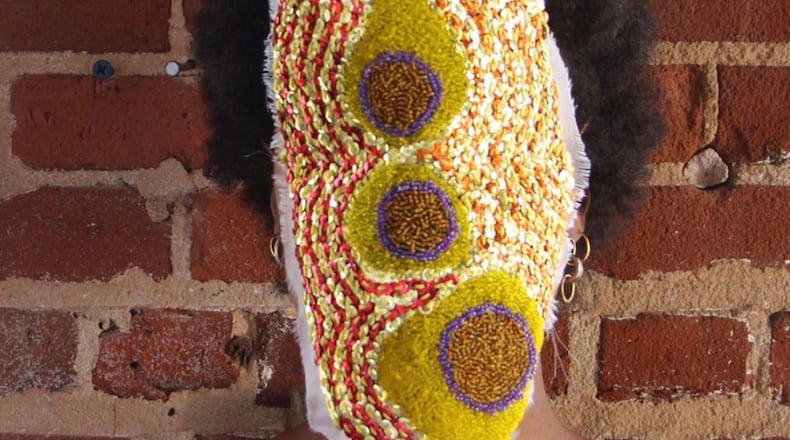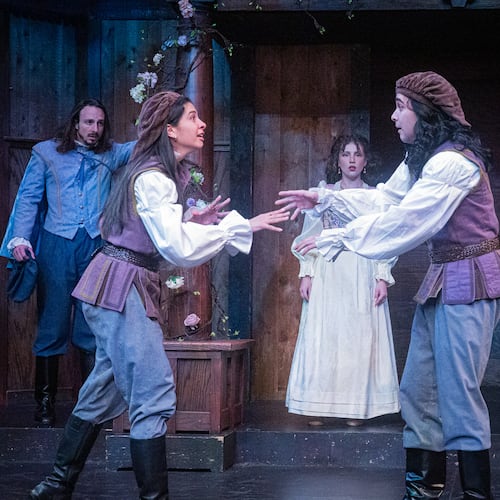If many of the stories of this moment in our history are about race and a virus, going forward, how will visual artists relay them?
Methods and mediums will vary. For Kelly Taylor Mitchell, it might be through popcorn and tar. Erin Jane Nelson might find inspiration in mold and microbes. Images of the swarm of an anthill, disturbed, or a cresting wave of masks might be how Davion Alston tells the tale of now for future audiences.
In the strict sense, Mitchell, Nelson and Alston, are not documentarians. Yet, scenes of mass protest spurned by police killings of Black people have been hard for them to escape. And, with the art world reeling from the effects of the COVID-19 pandemic — from museum and gallery closings to the cancellation of in-person art fairs, festivals and events — they know well that this is a time of peril for artists. But for the three Atlanta creatives, it is also a time of opportunity. They were recently selected as the latest fellows in the Museum of Contemporary Art of Georgia’s Working Artist’s Project (WAP).
This is the 13th year of the WAP program, which supports three, established Atlanta artists with a $15,000 grant, paid studio space and time, and an eight-week solo exhibition at MOCA GA at the end of the fellowship. The museum shut its doors in March and has yet to reopen, although, like many, it has turned to virtual tours. Despite the shutdown, MOCA GA leadership decided to move forward with the fellowship, enlisting Marcela Guerrero, an assistant curator at the Whitney Museum of American Art in New York City, as a juror to select the fellows. Instead of in-person studio visits, Guerrero and MOCA GA Founding Director Annette Cone-Skelton toured the candidates’ spaces and viewed their work on Zoom.
“It’s not ideal, but it allowed us to continue and not lose a year,” said Cone-Skelton. “I firmly believe artists have their thumbs on the future and where it’s going and especially these three artists because they sense not only the future but the underlying tension of the moment.”
Mitchell is an assistant professor of Art and Visual Culture and the art program director at Spelman College. A performance artist, she creates mixed-media installations that draw from the African diaspora. Nelson is a writer, curator and is the director of Burnaway.org, which covers Southeast contemporary artists and their work. Her work is in the permanent collection of the Whitney. Alston is a photographer whose work has been shown in Yale University’s Green Gallery, Art Basel Miami, and featured in The New York Times.
Credit: Kelly Taylor Mitchell
Credit: Kelly Taylor Mitchell
Here they talk about their work, the moment, and what’s to come. The Atlanta Journal-Constitution held interviews separately, and they have been edited for length and clarity.
Q: What was the first medium you worked with that felt like you could create the truest expression of who you are?
Mitchell: Drawing, but I think this idea of really feeling like this sense of being able to express myself and where I started to build a deeper relationship to process and labor was printmaking in high school. Printmaking is very precise, and it requires a lot of attention to detail, a lot of patience, which are all qualities I deeply admire but don’t necessarily have myself, which is why I think I’m drawn to it.
Nelson: My work has never been medium-specific, but I think I definitely started knowing I wanted to be an artist when I was in high school. At the time, I was really interested in science. I was a member of the science team and really kind of found myself as like a future biologist or doctor or going into some kind of scientific field, but was also very interested in art. And so, I feel like I’ve always had this kind of interest in things being sort of cross-disciplinary. So, the medium of collage and mixed media has always really called me.
Alston: I was first supported by being given a drawing pad in second or first grade by someone in my family. What affirmed my desire to understand art was in seventh grade, my godmother gifted me a DSLR camera. That ignited my interest with photography or the critical reality of photography.
Q: Kelly, you’ve used popcorn in your work, and tar and abaca appear in many of your pieces. What’s the appeal of the materials?
Mitchell: I’m really drawn to materials that carry their own histories, their own narratives. Like for example, popcorn, I was using in reference to an experience I had when I was in Bahia Brazil, which is the largest state of Afro Brazilians in Brazil. I was included in a blessing ceremony, and the blessing was informed by the history of Ormolu. That story is very similar to the biblical Lazarus. Popcorn was used as the sort of blessing material for this purpose of sort of cleansing and releasing things that really don’t serve you. If you think of a more Westernized Christian practice, you could maybe see the popcorn as the equivalent of holy water.
Q: You also use scent as an element in your work; cinnamon, peanuts, Florida Water. That’s unusual in a piece.
Mitchell: I really like smell as a trigger for memory. I have a library of smells, so cinnamon, or Florida Water or buttered popcorn. I’ve been trying to create a Hoppin’ John smell as well. And I think smell starts to subvert expectations we have for contemporary artwork.
Q: Erin, the theme of the natural world is present in most of your work.
Nelson: I feel like people are often talking about a beautiful forest and animals and things that are kind of at human scale. I’m really interested in things at all different scales. So, I love thinking about the colors of mold and the shape of microorganisms and the variety of scales and textures that exist in nature. And I’m interested in things that are kind of out of control or break down nature or have a different kind of logic. So, things like mold and mushrooms and water ecosystems that we come to understand as untamable.
Credit: Erin Jane Nelson
Credit: Erin Jane Nelson
Q: Davion, your work deals with the killings of Black people by police and confronts stereotypes about Blackness. I don’t want to say you are bound by the topic, because that’s reductive, but what binds you to it?
Alston: In 2012, I was called a (n-word) by this kid when me and my friend were walking by to go to a homecoming party at Valdosta State University. That same semester, Kendrick Thompson was found rolled up in a gym mat at Lowndes County High. I think that’s what motivated me. And I’m from the area where Ahmaud Arbery was killed. A lot of the work that I do is about the death of these kids and how we contend with it.
Q: How are the pandemic and this moment of racial reckoning affecting your work?
Nelson: Most of my work is traveling to barrier island sites to photograph, to collect material from. Not being able to travel has required me to think more about being alone in the studio and make things purely in response to my own feelings. I don’t know if it’s because I’ve been seeing so much, like that image of the coronavirus microbe, but I’ve definitely been thinking more about invisible microbes and what shape they are and how they’re kind of like nefarious but also like kind of cute little creatures.
One of the interesting things about the fellowship, it feels like a really unique opportunity to reflect on this moment politically and to really investigate some of the ways that maybe I’ve been complicit in institutionally racist structures or the ways my work has kind of fed into certain wealth inequality in regards to the people who collect, buy and show work.
Credit: Erin Jane Nelson
Credit: Erin Jane Nelson
Alston: I find the pandemic, honestly, to be like a great pause, a great reset. I’m hoping a lot of people put this as a time to return home, whether spiritually, mentally or physically, because I think those things are important.
How this affected my art-making for the next year is beautiful because I’m making work that desires. There’s a desire for gathering. And I’m interested in making work that understands that desire for gathering whether it be cultural, spiritual or protest. I’ve been using images from protests that I’ve been going to and conflating those with the same idea of what an ant bed looks like. I’m interested in the structure of an ant bed and how does the ant bed function and what does it look like once it’s stepped on.
Mitchell: I don’t think the pandemic has put a pause on anything for me or made me feel stagnant. It’s made me take further comfort in my work and my practice and articulate gratitude for that practice.
I know for a fact that the work serves as a balm. And I really think just choosing to be a Black person who is making themselves by making art, no matter what the art is, by doing something society tells Black people, people of color, queer people that they shouldn’t be doing…I think that also links into this idea of trying to resist.
About the Author
Keep Reading
The Latest
Featured









